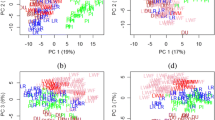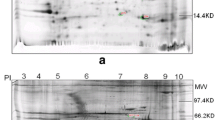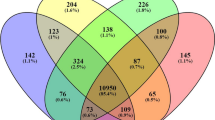Abstract
The pig could be a useful model to characterize molecular aspects determining several delicate phenotypes because they have been bred for those characteristics. The Korean native pig (KNP) is a regional breed in Korea that was characterized by relatively high intramuscular fat content and reddish meat color compared to other western breeds such as Yorkshire (YS). YS grew faster and contained more lean muscle than KNP. We compared the KNP to Yorksire to find molecular clues determining muscle characteristics. The comparison of skeletal gene expression profiles between these two breeds showed molecular differences in muscle. We found 82 differentially expressed genes (DEGs) defined by fold change (more than 1.5 fold difference) and statistical significance (within 5% of false discovery rate). Functional analyses of these DEGs indicated up-regulation of most genes involved in cell cycle arrest, down-regulation of most genes involved in cellular differentiation and its inhibition, down-regulation of most genes encoding component of muscular-structural system, and up-regulation of most genes involved in diverse metabolism in KNP. Especially, DEGs in above-mentioned categories included a large number of genes encoding proteins directly or indirectly involved in p53 pathway. Our results indicated a possible role of p53 to determine muscle characteristics between these two breeds.
Similar content being viewed by others
Refereces
Aksu, S., Koczan, D., Renne, U., Thiesen, H.J., and Brockmann, G.A. (2007). Differentially expressed genes in adipose tissues of high body weight-selected (obese) and unselected (lean) mouse lines. J. Appl. Genet. 48, 133–143.
Bennetts, J.S., Rendtorff, N.D., Simpson, F., Tranebjaerg, L., and Wicking, C. (2007). The coding region of TP53INP2, a gene expressed in the developing nervous system, is not altered in a family with autosomal recessive non-progressive infantile ataxia on chromosome 20q11-q13. Dev. Dyn. 236, 843–852.
Bensaad, K., and Vousden, K.H. (2007). p53: new roles in metabolism. Trends Cell. Biol. 17, 286–291.
Bensaad, K., Tsuruta, A., Selak, M.A., Vidal, M.N., Nakano, K., Bartrons, R., Gottlieb, E., and Vousden, K.H. (2006). TIGAR, a p53-inducible regulator of glycolysis and apoptosis. Cell 126, 107–120.
Brand, K.A., and Hermfisse, U. (1997). Aerobic glycolysis by proliferating cells: a protective strategy against reactive oxygen species. FASEB J. 11, 388–395.
Calhabeu, F., Lafont, J., Le Dreau, G., Laurent, M., Kazazian, C., Schaeffer, L., Martinerie, C., and Dubois, C. (2006). NOV/CCN3 impairs muscle cell commitment and differentiation. Exp. Cell Res. 312, 1876–1889.
Caruana, G., and Bernstein, A. (2001). Craniofacial dysmorphogenesis including cleft palate in mice with an insertional mutation in the discs large gene. Mol. Cell. Biol. 21, 1475–1483.
Casa, A.J., Dearth, R.K., Litzenburger, B.C., Lee, A.V., and Cui, X. (2008). The type I insulin-like growth factor receptor pathway: a key player in cancer therapeutic resistance. Front Biosci. 13, 3273–3287.
Chang, C., Martin, R.G., Livingston, D.M., Luborsky, S.W., Hu, C.P., and Mora, P.T. (1979). Relationship between T-antigen and tumor-specific transplantation antigen in simian virus 40-transformed cells. J. Virol. 29, 69–75.
Chitnis, M.M., Yuen, J.S., Protheroe, A.S., Pollak, M., and Macaulay, V.M. (2008). The type 1 insulin-like growth factor receptor pathway. Clin. Cancer Res. 14, 6364–6370.
Choi, K.Y., Moon, J.K., Choi, S.H., Kim, K.S., Choi, Y.I., Kim, J.J., and Lee, C.K. (2008). Differential expression of cytochrome P450 genes regulate the level of adipose arachidonic acid in Sus scrofa. Asia-Aust. J. Anim. Sci. 21, 967–971.
Chumakov, P.M. (2007). Versatile functions of p53 protein in multi-cellular organisms. Biochemistry 72, 1399–1421.
Daaka, Y., Pitcher, J.A., Richardson, M., Stoffel, R.H., Robishaw, J.D., and Lefkowitz, R.J. (1997). Receptor and G betagamma isoform-specific interactions with G protein-coupled receptor kinases. Proc. Natl. Acad. Sci. USA 94, 2180–2185.
Dittmer, J. (2003). The biology of the Ets1 proto-oncogene. Mol. Cancer 2, 29.
Draviam, V.M., Stegmeier, F., Nalepa, G., Sowa, M.E., Chen, J., Liang, A., Hannon, G.J., Sorger, P.K., Harper, J.W., and Elledge, S.J. (2007). A functional genomic screen identifies a role for TAO1 kinase in spindle-checkpoint signalling. Nat. Cell Biol. 9, 556–U136.
Dzeja, P., and Terzic, A. (2009). Adenylate kinase and AMP signaling networks: metabolic monitoring, signal communication and body energy sensing. Int. J. Mol. Sci. 10, 1729–1772.
Fischer, R.S., and Fowler, V.M. (2003). Tropomodulins: life at the slow end. Trends Cell Biol. 13, 593–601.
Flores, C., Ma, S.F., Maresso, K., Ober, C., and Garcia, J.G. (2007). A variant of the myosin light chain kinase gene is associated with severe asthma in African Americans. Genet. Epidemiol. 31, 296–305.
Guo, Z., Linn, J.F., Wu, G., Anzick, S.L., Eisenberger, C.F., Halachmi, S., Cohen, Y., Fomenkov, A., Hoque, M.O., Okami, K., et al. (2004). CDC91L1 (PIG-U) is a newly discovered oncogene in human bladder cancer. Nat. Med. 10, 374–381.
Han, X., Budreau, A.M., and Chesney, R.W. (2000). Identification of promoter elements involved in adaptive regulation of the taurine transporter gene: role of cytosolic Ca2+ signaling. Adv. Exp. Med. Biol. 483, 535–544.
Huang, J., Xu, L.G., Liu, T., Zhai, Z., and Shu, H.B. (2006). The p53-inducible E3 ubiquitin ligase p53-RFP induces p53-dependent apoptosis. FEBS Lett. 580, 940–947.
Hwang, I., Park, B., Cho, S., Kim, J., Choi, Y., and Lee, J. (2004). Identification of muscle proteins related to objective meat quality in Korean native black pig. Asian-Australasian J. Anim. Sci. 17, 1599–1607.
Iizuka-Kogo, A., Ishidao, T., Akiyama, T., and Senda, T. (2007) Abnormal development of urogenital organs in Dlgh1-deficient mice. Development 134, 1799–1807.
Iotsova, V., Crepieux, P., Montpellier, C., Laudet, V., and Stehelin, D. (1996) TATA-less promoters of some Ets-family genes are efficiently repressed by wild-type p53. Oncogene 13, 2331–2337.
Jeon, J.T., Park, E.W., Jeon, H.J., Kim, T.H., Lee, K.T., and Cheong, I.C. (2003). A large-insert porcine library with sevenfold genome coverage: a tool for positional cloning of candidate genes for major quantitative traits. Mol. Cells 16, 113–116.
Kim, H.J., and Lee, W.J. (2009). Insulin-like growth factor-I induces androgen receptor activation in differentiating C2C12 skeletal muscle cells. Mol. Cells 28, 189–194.
Kim, K.S., Yeo, J.S., and Kim, J.W. (2002). Assessment of genetic diversity of Korean native pig (Sus scrofa) using AFLP markers. Genes Genet. Syst. 77, 361–368.
Kim, T.H., Choi, B.H., Chang, G.W., Lee, K.T., Lee, H.Y., Lee, J.H., Kim, K.S., Park, C.K. and Moran, C. (2005a). Molecular characterization and chromosomal mapping of porcine adipose differentiation-related protein (ADRP). J. Anim. Breed Genet. 122, 240–246.
Kim, T.H., Kim, K.S., Choi, B.H., Yoon, D.H., Jang, G.W., Lee, K.T., Chung, H.Y., Lee, H.Y., Park, H.S., and Lee, J.W. (2005b). Genetic structure of pig breeds from Korea and China using microsatellite loci analysis. J. Anim. Sci. 83, 2255–2263.
Kim, N., Lim, J., Song, M., Kim, O., Park, B., Kim, M., Hwang, I., and Lee, C. (2008). Comparisons of longissimus muscle metabolic enzymes and muscle fiber types in Korean and western pig breeds. Meat Sci. 78, 455–460.
Kress, M., May, E., Cassingena, R., and May, P. (1979). Simian virus 40-transformed cells express new species of proteins precipitable by anti-simian virus 40 tumor serum. J. Virol. 31, 472–483.
Lane, D.P., and Crawford, L.V. (1979). T antigen is bound to a host protein in SV40-transformed cells. Nature 278, 261–263.
Li, J., Rao, H., Burkin, D., Kaufman, S.J., and Wu, C. (2003). The muscle integrin binding protein (MIBP) interacts with alpha7beta1 integrin and regulates cell adhesion and laminin matrix deposition. Dev. Biol. 261, 209–219.
Linossier, M.T., Dormois, D., Perier, C., Frey, J., Geyssant, A., and Denis, C. (1997). Enzyme adaptations of human skeletal muscle during bicycle short-sprint training and detraining. Acta Physiol. Scand. 161, 439–445.
Linzer, D.I., and Levine, A.J. (1979). Characterization of a 54K dalton cellular SV40 tumor antigen present in SV40-transformed cells and uninfected embryonal carcinoma cells. Cell 17, 43–52.
Liu, C., Kronenberg, M., Jiang, X., Rowe, D., and Hadjiargyrou, M. (2007). Characterization of Mustn1 PRO-GFPtpz transgenic mice, pp. 13–14.
Lynch, G.S., and Ryall, J.G. (2008). Role of beta-adrenoceptor signaling in skeletal muscle: implications for muscle wasting and disease. Physiol. Rev. 88, 729–767.
Mahajan, M.A., Murray, A., Levy, D., and Samuels, H.H. (2007). Nuclear receptor coregulator (NRC): mapping of the dimerization domain, activation of p53 and STAT-2, and identification of the activation domain AD2 necessary for nuclear receptor signaling. Mol. Endocrinol. 21, 1822–1834.
Malik, S., and Roeder, R.G. (2000). Transcriptional regulation through Mediator-like coactivators in yeast and metazoan cells. Trends Biochem. Sci. 25, 277–283.
McTavish, N., Copeland, L.A., Saville, M.K., Perkins, N.D., and Spruce, B.A. (2007). Proenkephalin assists stress-activated apoptosis through transcriptional repression of NF-kappaB- and p53-regulated gene targets. Cell Death Differ. 14, 1700–1710.
Moolenaar, W.H. (1995). Lysophosphatidic acid, a multifunctional phospholipid messenger. J. Biol. Chem. 270, 12949–12952.
Moon, J.K., Kim, K.S., Kim, J.J., Choi, B.H., Cho, B.W., Kim, T.H., and Lee, C.K. (2009). Differentially expressed transcripts in adipose tissue between Korean native pig and Yorkshire breeds. Anim. Genet. 40, 115–118.
Murphy, M., Hinman, A., and Levine, A.J. (1996). Wild-type p53 negatively regulates the expression of a microtubule-associated protein. Genes Dev. 10, 2971–2980.
Nadon, R., and Shoemaker, J. (2002). Statistical issues with microarrays: processing and analysis. Trends Genet. 18, 265–271.
Narayan, N., Massimi, P., and Banks, L. (2009). CDK phosphorylation of the discs large tumour suppressor controls its localisation and stability. J. Cell Sci. 122, 65–74.
Nedivi, E., Wu, G.Y., and Cline, H.T. (1998) Promotion of dendritic growth by CPG15, an activity-induced signaling molecule. Science 281, 1863–1866.
Omwancha, J., Zhou, X.F., Chen, S.Y., Baslan, T., Fisher, C.J., Zheng, Z., Cai, C., and Shemshedini, L. (2006). Makorin RING finger protein 1 (MKRN1) has negative and positive effects on RNA polymerase II-dependent transcription. Endocrine 29, 363–373.
Qi, R.Z., Ching, Y.P., Kung, H.F., and Wang, J.H. (2004) alpha-Chimaerin exists in a functional complex with the Cdk5 kinase in brain. FEBS Lett. 561, 177–180.
Schabort, E.J., van der Merwe, M., Loos, B., Moore, F.P., and Niesler, C.U. (2009). TGF-beta’s delay skeletal muscle progenitor cell differentiation in an isoform-independent manner. Exp. Cell Res. 315, 373–384.
Seale, P., Ishibashi, J., Holterman, C., and Rudnicki, M.A. (2004). Muscle satellite cell-specific genes identified by genetic profiling of MyoD-deficient myogenic cell. Dev. Biol. 275, 287–300.
Srikakulam, R., Liu, L., and Winkelmann, D.A. (2008). Unc45b forms a cytosolic complex with Hsp90 and targets the unfolded myosin motor domain. PLoS ONE 3, e2137.
Sugiura, N., Dadashev, V., and Corriveau, R.A. (2004). NARG2 encodes a novel nuclear protein with (S/T)PXX motifs that is expressed during development. Eur. J. Biochem. 271, 4629–4637.
Takeda, K., Yu, Z.X., Qian, S., Chin, T.K., Adelstein, R.S., and Ferrans, V.J. (2000). Nonmuscle myosin II localizes to the Zlines and intercalated discs of cardiac muscle and to the Z-lines of skeletal muscle. Cell Motil. Cytoskeleton 46, 59–68.
Tomasini, R., Samir, A.A., Carrier, A., Isnardon, D., Cecchinelli, B., Soddu, S., Malissen, B., Dagorn, J.C., Iovanna, J.L., and Dusetti, N.J. (2003). TP53INP1s and homeodomain-interacting protein kinase-2 (HIPK2) are partners in regulating p53 activity. J. Biol. Chem. 278, 37722–37729.
Tsai, S., Cassady, J.P., Freking, B.A., Nonneman, D.J., Rohrer, G.A., and Piedrahita, J.A. (2006). Annotation of the Affymetrix porcine genome microarray. Anim. Genet. 37, 423–424.
Walsh, C.T., Radeff-Huang, J., Matteo, R., Hsiao, A., Subramaniam, S., Stupack, D., and Brown, J.H. (2008). Thrombin receptor and RhoA mediate cell proliferation through integrins and cysteinerich protein 61. FASEB J. 22, 4011–4021.
Weber, A., Pennise, C.R., Babcock, G.G., and Fowler, V.M. (1994). Tropomodulin caps the pointed ends of actin-filaments. J. Cell Biol. 127, 1627–1635.
Yamamoto, H., Tsukahara, K., Kanaoka, Y., Jinno, S., and Okayama, H. (1999). Isolation of a mammalian homologue of a fission yeast differentiation regulator. Mol. Cell. Biol. 19, 3829–3841.
Zhao, J., Zhang, X., Shi, M., Xu, H., Jin, J., Ni, H., Yang, S., Dai, J., Wu, M., and Guo, Y. (2006). TIP30 inhibits growth of HCC cell lines and inhibits HCC xenografts in mice in combination with 5-FU. Hepatology 44, 205–215.
Author information
Authors and Affiliations
Corresponding author
About this article
Cite this article
Kim, SS., Kim, JR., Moon, JK. et al. Transcriptional alteration of p53 related processes as a key factor for skeletal muscle characteristics in Sus scrofa . Mol Cells 28, 565–573 (2009). https://doi.org/10.1007/s10059-009-0159-z
Received:
Accepted:
Published:
Issue Date:
DOI: https://doi.org/10.1007/s10059-009-0159-z




